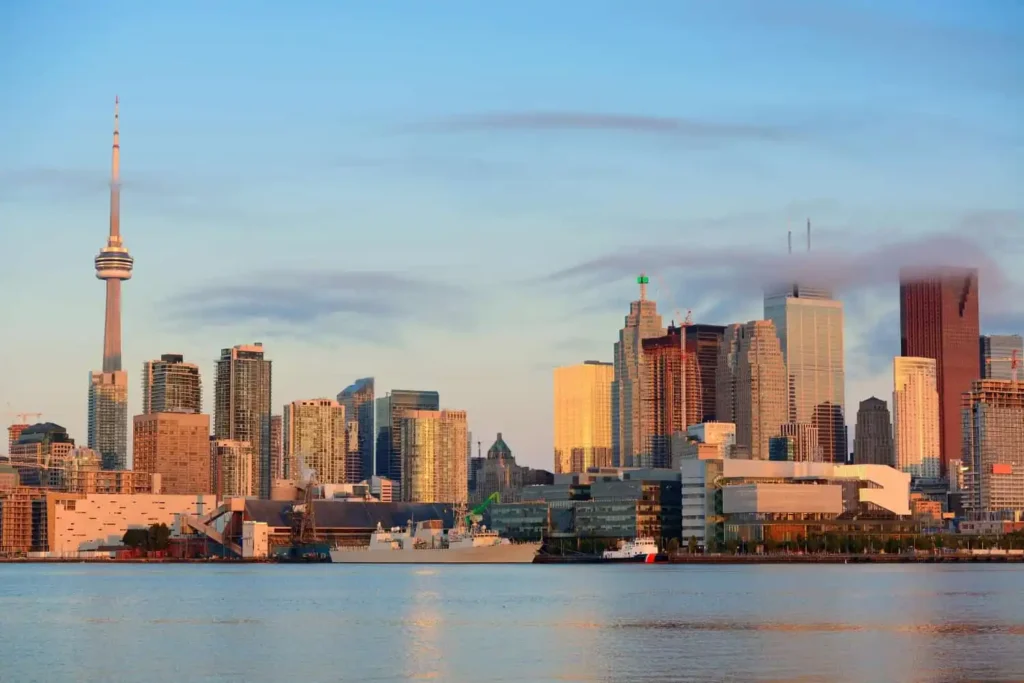Canada stands out as a country with steady economic indicators, social stability, and access to universal services. For those looking to live in Canada, the quality of life in cities plays a key role in decision-making.
According to the Economist Intelligence Unit’s latest Global Liveability Index, Canadian cities continue to rank high. And in this article, we’ll cover the best places to live in Canada in 2025.
The Best Cities to Live in Canada
Across Canada, different cities offer different strengths—whether it’s job prospects, climate, culture, or affordability. Below is a closer look at some of the most talked-about places to live in Canada in 2025.

Vancouver, British Columbia
Surrounded by ocean and mountains, Vancouver remains one of Canada’s most recognizable cities. Its blend of nature and urban infrastructure draws immigrants, students, and professionals from around the world. As of 2021, the metro area was home to more than 2.6 million people, with about 50% identifying as a visible minority.
Advantages of living in Vancouver
- Regularly ranks among the most livable cities globally. In 2025, it placed 10th on the EIU index.
- Home to the University of British Columbia (UBC), one of Canada’s top universities.
- Public transportation is extensive and includes buses, SkyTrain, and SeaBus.
- Access to outdoor activities year-round—skiing, hiking, cycling, and kayaking.
- Highly diverse population with established communities from China, India, the Philippines, and Iran.
- Mild coastal climate compared to most other major Canadian cities.
Disadvantages of living in Vancouver
- The most expensive housing market in Canada. As of early 2025, average home prices are just under $1.2 million.
- Rent has also increased steadily, with average monthly costs for a one-bedroom over $2,700.
- Traffic congestion remains an issue during peak hours.
- Limited urban land means new housing developments are often vertical and dense.
- Some residents report long wait times in healthcare, especially in certain specialties.

Calgary, Alberta
Located near the foothills of the Rocky Mountains, Calgary is known for its balance of career opportunities and affordability. It’s also one of the youngest cities demographically in Canada. Calgary’s metro population was estimated at over 1.5 million in 2024, with steady growth expected.
Advantages of living in Calgary
- No provincial sales tax, which reduces the overall cost of living.
- Housing remains more accessible than in Toronto or Vancouver. Detached homes average around $570,000.
- Access to nature is a big plus—Banff National Park is about 90 minutes away.
- Employment sectors include energy, agriculture, aerospace, and logistics.
- One of the sunniest major cities in Canada, with more than 330 days of sunshine annually.
- Consistently ranked in the top three Canadian cities for overall quality of life.
Disadvantages of living in Calgary
- Winters are long and cold, with temperatures often dropping below −20°C.
- Economic dependence on the energy sector leaves the city vulnerable to market shifts.
- Public transportation, while improving, covers fewer areas than larger metros.
- Fewer cultural institutions compared to Toronto or Montreal, though this is changing gradually.

Toronto, Ontario
Toronto is the economic and population centre of Canada. It’s the largest city in the country, and the Greater Toronto Area is home to over 7 million people. It’s also one of the most linguistically diverse cities in the world.
Advantages of living in Toronto
- Major employment centre with strong finance, tech, education, and healthcare sectors.
- Home to the University of Toronto, Ryerson University, and York University.
- Broad cultural offerings: international cuisine, museums, music venues, and festivals.
- Robust public transit network that includes buses, subways, streetcars, and regional rail.
- More than 200 ethnic origins are reported among residents; multicultural events occur year-round.
- Air travel access via Pearson International Airport connects to major global destinations.
Disadvantages of living in Toronto
- High housing costs. As of early 2025, the average home price in the GTA was just over $1.1 million.
- Rent continues to rise, with many one-bedroom units exceeding $2,600 per month.
- Traffic congestion is a major concern, and commute times can stretch beyond an hour.
- Urban sprawl has expanded into surrounding cities, increasing travel time for many residents.
- Property taxes and other costs add up quickly for homeowners.
 , Ontario
, Ontario
Canada’s capital offers a slower pace than Toronto or Vancouver, but is often ranked among the safest and cleanest cities in the country. It’s home to a number of government departments, international embassies, and cultural institutions.
Advantages of living in Ottawa
- Stable employment base, particularly in public administration and tech.
- Average home prices are lower than in Vancouver or Toronto—around $650,000.
- Access to both English and French services.
- Museums, the National Gallery, and Parliament Hill offer cultural and civic engagement.
- The city is compact and easily navigable by bike or public transit.
- Consistently rates high for air quality and green space.
Disadvantages of living in Ottawa
- Winters can be harsh, with heavy snowfall and freezing rain.
- Limited nightlife and entertainment options compared to larger cities.
- Economic diversity is narrower, relying heavily on government employment.
- Some newcomers find the social scene quieter or harder to break into.

Montreal, Quebec
Montreal feels lively, creative, and uniquely Canadian. Often called “Canada’s cultural capital,” it blends European flair with North American energy. Home to about 1.78 million people, the city scores well for social offerings and overall affordability.
Art festivals? Plenty. Historic architecture and graffiti art dot neighborhoods. Nearly 30 CEGEPs and four major universities cluster downtown; Montreal has the highest student-to-resident ratio in North America at 4.38 per 100 residents. The underground network (RÉSO), 32 km long, connects much of the city in winter and rain.
Advantages of living in Montreal
- Generally, lower rent and living expenses than in Canada’s major cities. Monthly living costs average around CAD 2,374 for a single person.
- Vibrant festivals and lots of year-round cultural events—from jazz to comedy—plus a rich food scene.
- Bilingualism is a strength. You’ll live among connected communities speaking both French and English.
- Young and highly educated population, thanks to its dense cluster of universities and colleges.
- Extensive public transit: metro, buses, commuter trains, ferries—and one of the longest pedestrian underground networks in the world.
Disadvantages of living in Montreal
- Winters can be brutal. Heavy snow, freezing temperatures dipping to −20 °C or below are common.
- Public sector and many service sector roles often require French language skills.
- Average wages remain lower than in cities like Toronto or Calgary—sometimes limiting earning potential.
- Traffic delays crop up around the bridges and autoroutes linking suburbs; congestion remains a persistent issue.

Winnipeg, Manitoba
Winnipeg surprises many. A prairie city of roughly 750,000, it’s often overlooked—but it offers an affordable lifestyle, open skies, and festivals that attract visitors from across Canada. The economy is varied: healthcare, public administration, manufacturing, retail, and logistics all play a role.
Winnipeg is also one of the sunniest big cities in the country—over 2,350 hours per year—and boasts a walkable downtown sheltered by the skywalk system linking offices, shops, libraries, and restaurants.
Advantages of living in Winnipeg
- The cost of living is significantly lower than in Vancouver, Toronto, or Montreal. Housing, utilities, and groceries remain budget-friendly.
- A slower pace of life, often noted by families and newcomers as easier to settle into.
- Cultural calendar includes Folklorama, Winnipeg Folk Festival, Jazz Winnipeg, Fringe Theatre, and the Canadian Museum for Human Rights.
- Diverse neighbourhoods and growing film and music industries provide local jobs and creative energy.
- Easy pedestrian access downtown via covered skywalks is helpful in the winter months.
Disadvantages of living in Winnipeg
- Crime rates, especially violent incidents, are higher than in many Canadian cities. Homicide and gun violence remain concerns, particularly in certain neighbourhoods.
- Winters are long, bitter, and at times extreme. Wind chill can fall near −40 °C.
- Public transit is less comprehensive. Buses serve major routes, but many opt for cars outside key corridors.
- Geographic isolation: long distances separate Winnipeg from other major Canadian centres—sometimes over 25 hours’ drive.
- Job growth is steady but often slower; wages in some sectors lag larger urban markets.




 , Ontario
, Ontario




